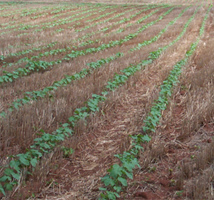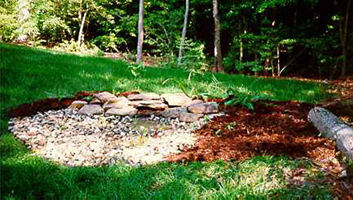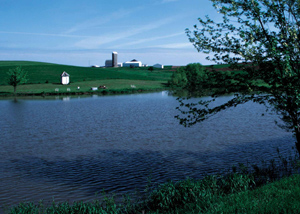- What Are Best Management Practices?
- How Do BMPs Help the Environment?
- Agencies that Offer Assistance
- Summary
- Acknowledgments
What Are Best Management Practices?
Best Management Practices (BMPs) can be described as management and/or structural practices that are designed to reduce pollutants and erosion while increasing the quality of all life. The BMP concept deals specifically with nonpoint source pollution, such as runoff from agricultural fields, forest areas or urban areas. Best management practices are also voluntary in nature. Individual practices and applications can vary widely from field to field. Best management practices are typically used in agricultural areas and forest and urban settings.
Agricultural BMPs (Figures 1a, 1b, and 1c) are typically used on production fields, in livestock operations, and in urban settings to increase infiltration and reduce runoff, erosion, and pesticide use. These practices may also include using measures to reduce the potential spread of chemicals from containment areas. Other agricultural BMPs may consist of limiting cattle access to streams, providing high-use watering areas or providing solar water pumping stations away from water bodies. In urban settings, the use of bio-retention ponds or areas provides an attractive way to control erosion and runoff and increase infiltration.
Forest/wildlife habitat BMPs (Figure 1d) are typically used in forest settings or in forest areas adjacent to agricultural fields for purposes of reducing runoff to and sedimentation in streams and increasing wildlife populations. Some of these practices may include site preparation, reforesting plans, and harvesting operations, habitat restoration, ground cover/brush implementation, wildfire management, and food/water source management.
Riparian zone BMPs can include buffer zone restoration, erosion control, and habitat restoration. While the individual plans can be different, they all lead to the same goal: improving and conserving the surrounding environment for both people and wildlife.




Figures 1a-d. Best management practices are structures and practices designed to prevent or reduce water pollution. The four photographs above show some practices used in agriculture and forestry.
How Do BMPs Help the Environment?
Best management practice implementation aids the Earth's natural life support system. A plan that includes practices to control erosion leads to longer useful soil life, better habitat for soil organisms, cleaner surface waters, and topsoil conservation. Water quality plans may include practices that account for nonpoint source pollutant reductions, point source pollutants, ground and surface water testing, aquatic habitat restoration, and improved and diverse soil micro and macro biology (Figure 2). Air quality plans may include practices such as tighter restrictions for particulate waste from industry factories, noise buffers, wind erosion control and emissions standards for automobiles.


Agencies that Offer Assistance
Many BMPs are currently voluntary; however, it may not be long before they become mandatory. To help implement BMPs, many agencies have a variety of programs available to assist farmers and stakeholders in determining which practices best fit their specific needs. Several programs offer some kind of financial assistance, usually in the way of a cost-share percentage. Many programs offer technical assistance in which the agency or entity offering the program will help the individual set up the BMP plan.
Within Georgia, agencies offering help to farmers and stakeholders include: UGA Cooperative Extension, USDA Natural Resources Conservation Service (NRCS), Georgia Soil and Water Conservation Commission (GASWCC), Georgia Department of Natural Resources (DNR) and the U.S. Department of Agriculture–Farm Service Agency (USDA FSA). While it may seem that a lot of these agencies are all doing the same things, they each have different responsibilities regarding conservation. In other states, sister agencies to these in Georgia can help farmers and stakeholders.
A brief description of how each agency helps implement BMPs for the conservation of natural resources is presented below.
University of Georgia Cooperative Extension
UGA Cooperative Extension does not provide monetary assistance to farmers and stakeholders, but instead provides science-based information on various BMPs. Cooperative Extension can work with farmers and other agencies to determine what potential science-based options are available. For more information on how UGA Cooperative Extension can assist you, call 1-800-ASK-UGA1 or visit extension.uga.edu.
Natural Resources Conservation Service (NRCS)
The NRCS mission statement says: "The Natural Resources Conservation Service provides leadership in a partnership effort to help people conserve, maintain, and improve our natural resources and environment." Through the use of government cost-share programs and technical assistance programs, the agency helps people help themselves. Several of the programs offered include varying degrees of cost-sharing. This benefits the environment, the agency, people already using the programs, as well as anyone who would want to use the programs in the future. Find more information about NRCS programs and your local office on their website (https://www.nrcs.usda.gov).
Georgia Soil and Water Conservation Commission (GSWCC)
GASWCC's mission is to protect, conserve and improve soil and water quality in Georgia. It differs from NRCS in that it focuses specifically on soil and water quality, while NRCS addresses all natural resources. Assistance provided from GSWCC consists of cost-share funds for improving irrigation efficiency, collecting and storing irrigation water, improving wildlife habitat, and improving urban soil and water management. Their website has more information about the programs offered (https://gaswcc.georgia.gov).
Georgia Forestry Commission (GFC)
The Georgia Forestry Commission provides leadership, service and education in the protection and conservation of Georgia's forest resources. Their main goal is to maintain a healthy, sustainable forest that provides clean air, clean water and abundant products for the future. The GFC provides information on the use of conservation easements and forestry-related grants.
USDA Farm Service Agency (FSA)
FSA's vision statement says it is: "A customer-driven agency with a diverse and multi-talented work force, dedicated to achieving an economically and environmentally sound future for American Agriculture." Whereas some of the other agencies aim toward the environment and environmental landmarks, FSA is more concerned with people. The agency ensures the well-being of U.S. agriculture through efficient and equitable administration of farm commodity programs, conservation and environmental programs, emergency and disaster assistance, domestic and international food assistance, and international export credit programs. These programs are part of USDA's farm safety net, which helps maintain viable operations, compete for export sales of commodities, and contributes to year-round availability of low-cost, safe, and nutritious foods. The FSA offers assistance through these listed cost-share programs specifically dealing with long-term and emergency farmland conservation. The FSA website has information on available programs and how to find your local FSA office (https://www.fsa.usda.gov).
Georgia Department of Natural Resources (GADNR)
The Georgia DNR centers on natural resources as well as cultural and historic resources. They promote areas of the state that have significant historical and cultural value while also protecting and supporting state parks and archeological areas. To assist citizens with various aspects of protecting natural resources, the GADNR is divided into six topic-specific divisions: Coastal Resources; Environmental Protection; Historic Preservation; Parks, Recreation, and Historic Sites; Program Support; and Wildlife Resources. Funds available from the divisions of the DNR are specific to those divisions and may consist of technical or financial assistance. For more information, see the GADNR website (https://gadnr.org).
Summary
BMPs are valuable tools used on a voluntary basis by farmers and stakeholders to improve the environmental and personal quality of the land they own. Within Georgia, there are many programs available to assist farmers and stakeholders in planning for and implementing BMPs. If you have any questions or need assistance with any of the listed programs, contact the appropriate agency or see your local UGA Extension agent.
Acknowledgments
It is only with the help of many people within each of the state agencies, including Georgia Department of Natural Resources, Georgia Natural Resources Conservation Service, Farm Service Agency, and Georgia Soil and Water Conservation Commission, that this publication could be assembled. For more information on each agency, refer to their individual websites.
For more detailed information on how conservation has been implemented on the ground through federal programs, refer to reports on the Conservation Effects Assessment Project (CEAP) website (https://www.nrcs.usda.gov/ceap/publications).
Funding for the original work in this publication was provided by a grant from the USDA-CSREES Integrated Research, Extension, and Education Program (Award No. 2005-51130-02377), by Hatch and State funds allocated to the Georgia Agricultural Experiment Stations, and the Georgia Department of Natural Resources in the former Pollution Prevention Assistance Division.



Status and Revision History
Published on Feb 19, 2008
In Review for Minor Revisions on Feb 19, 2011
Unpublished/Removed on Jul 03, 2012
Published with Minor Revisions on Jul 31, 2013
Published with Minor Revisions on Jul 22, 2024


























































